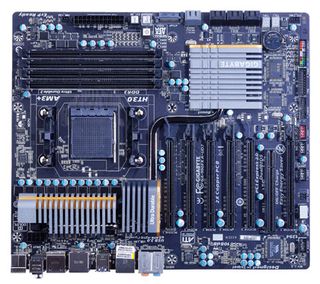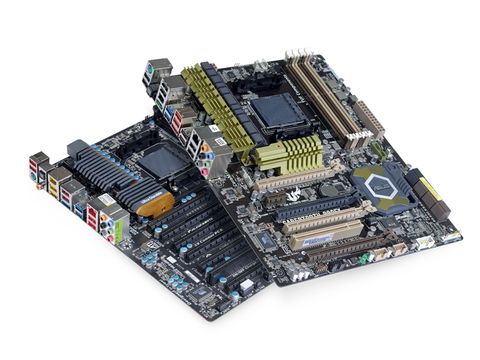TechRadar Verdict
Pros
- +
Up to four way SLI support
- +
AM3 backwards compatible
- +
USB 3.0 support
- +
SATA 6Gbps support
Cons
- -
No Bulldozer chips...yet
- -
Playing catch-up with Intel chips
Why you can trust TechRadar
The AMD 990FX is a new motherboard chipset, and the first two strapping motherboards are definitely aimed at enthusiasts. This means we'll get a clearer insight into exactly what this chipset is capable of.
There is a problem, though - the 990FX chipset is all about adding support for AMD's formidably titled and mysterious Bulldozer CPUs. For the first time since 2003, AMD is building a CPU architecture from the ground up, and targeting Intel's i5/i7 2500/2600 range; the current cream of the CPU crop.
And here's the problem – the 990FX boards are sitting pretty on our test rigs and Bulldozer remains a couple of months away from launch at best. It's likely to hit the shelves around early September.
What we do know about Bulldozer, suggests that motherboards that support it will be in high demand. The primary innovation from AMD's 32nm chip can be found in the cores department.
A 'core' on a Bulldozer CPU isn't what we're used to from Intel's chips, that's for sure. In Intel cores, one multi-purpose scheduler deals with integer and fl oating point logic. The Bulldozer module itself has two integer cores. Each integer core has its own L1 cache and integer scheduler logic, but just one floating point scheduler per Bulldozer module.
Beyond that, there's shared L2 and L3 cache for both integer cores in the Bulldozer module. So a quad-core Bulldozer CPU would comprise of two Bulldozer modules, and the eight-core CPUs will be built from four Bulldozer modules. We're taking the opportunity to coin the phrase quad-mod…
With this architecture, there can be no single-core operation, as the two cores in each module share fetch and decode architecture, as well as that L2/3 cache. Those eight core, quad-mod Bulldozer chips should match the i7 2600K pace for pace.
Intel's chip is a four core, eight-threaded affair, while the Bulldozer chip will have – ostensibly – eight actual cores. Hyperthreading gives a performance boost of around 25 per cent out of one core, and AMD is promising 80 per cent performance boosts from the second integer core on a single module.
The full multi
All that processing magic will appear on store shelves in Zambezi quad-mod chips before you'll be digging your winter coat out, but for existing AMD CPU customers, the Bulldozer-ready Asus Sabertooth 990FX and Gigabyte GA-990FXA-UD7 still have features to offer right now.
First, there's a landmark moment for AMD boards and multi-GPU. It's available on both motherboards.
Gigabyte's board will actually support 4-way SLI or CrossFireX setups, and the Sabertooth can hack three-way support. This is quite a big selling point for loyal AMD gamers – these are the first mobos to support Nvidia's multi-GPU tech, and the very fact it's included suggests Bulldozer has the grunt to match SLI'd GPUs.
The 990FX retains SATA 6 Gbps support from 8 series boards, and Gigabyte has made full use of this by including eight SATA 3 ports. Asus isn't really leaving anyone wanting by including just six SATA 3 and two SATA 2 ports, but it's worth bearing in mind when figuring out why the Gigabyte board is pricier.
Sadly, there's no native USB 3.0 support as many were hoping. It's still handled by an onboard controller limiting the number of ports. Both boards have just four USB 3.0 ports, and 14 USB 2.0 ports.

It seemed like a good opportunity to get the jump on Intel as it works to get USB 3.0 to co-exist with Thunderbolt. In fact, the Southbridge is the same SB950 from the previous AMD chipset, save for opimitisations in USB 3.0 and PCI-e data paths.
AMD is great at backwards compatibility and this chipset carries that consumer-friendly torch. It's good to go with Bulldozer chips when they arrive too, but they're also happy with any existing AM3 processors. That's an enticing prospect: SLI, SATA 6 GBps and USB 3.0 now, and one simple upgrade to a Zambezi CPU later.
Lovely pair
Motherboards are hardly the Venus De Milo of PC hardware, but this pair are easy on the eye.
Asus' Sabertooth board comes without that TUF thermal armour that gives its P67 iteration that distinctive look, and sports the rugged design and heatsinks painted in ubiquitous military tones. There's plenty of space to fit a cooler, the side-mounted SATA ports are out of your GPU's way, and it's compact enough to fit in most cases despite supporting three GPUs.
Gigabyte's board looks great too, which is a pleasant surprise after their gimmicky Assassin enthusiast range. It's bigger and more spacious than the Asus. Again, fitting any cooler shouldn't be a problem and despite cramming four GPUs into its little beige mouths, it's less of a space hog than some four-way SLI boards we've seen.
Both boards are capable overclockers, and here Asus' BIOS and AI suite betters the Gigabyte, making the process smoother and drawing slightly higher results.
There's not a lot separating them in the functionality stakes. If you want to use four graphics cards and eight SATA 6Gbps storage devices, the choice is obvious. Only Gigabyte's GA-990FXA-UD7 can do that. It's a small niche though.
During our testing, the GA-990FXA-UD7 outperformed the Sabertooth 990FX significantly in CPU-heavy tasks, such as video encoding and rendering. Not the marginal results we're used to in motherboard tête-à-têtes; actual noticeable differences. Factoring in a Bulldozer upgrade, that's a big plus.
GPU performances are much tighter, and Asus' board comes up tops in some benchmarks, but we're talking decimals.

Benchmarks
DirectX 11 tessellation performance:
Asus SaberTooth 990FX: 21.5
Gigabyte GA-990FXA-UD7: 21.8
DirectX 11 gaming performance: DiRT 2 (FPS: Higher is better)
Asus SaberTooth 990FX: 74.7
Gigabyte GA-990FXA-UD7: 74.1
DirectX 11 gaming performance: Far Cry 2 (FPS: Higher is better)
Asus SaberTooth 990FX: 74.59
Gigabyte GA-990FXA-UD7: 74.62
Video encoding performance: x264 HD v2 (FPS: Higher is better)
Asus SaberTooth 990FX: 22
Gigabyte GA-990FXA-UD7: 24
Follow TechRadar Reviews on Twitter: http://twitter.com/techradarreview

Ad creative by day, wandering mystic of 90s gaming folklore by moonlight, freelance contributor Phil started writing about games during the late Byzantine Empire era. Since then he’s picked up bylines for The Guardian, Rolling Stone, IGN, USA Today, Eurogamer, PC Gamer, VG247, Edge, Gazetta Dello Sport, Computerbild, Rock Paper Shotgun, Official PlayStation Magazine, Official Xbox Magaine, CVG, Games Master, TrustedReviews, Green Man Gaming, and a few others but he doesn’t want to bore you with too many. Won a GMA once.

